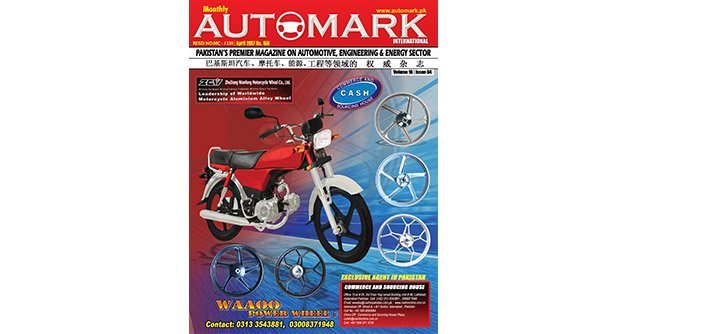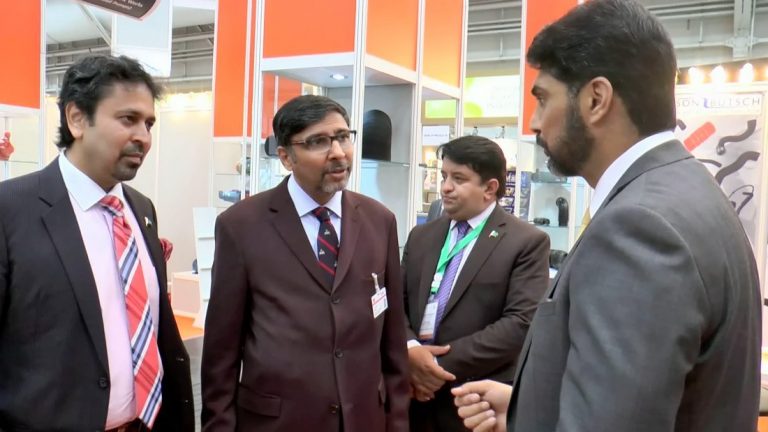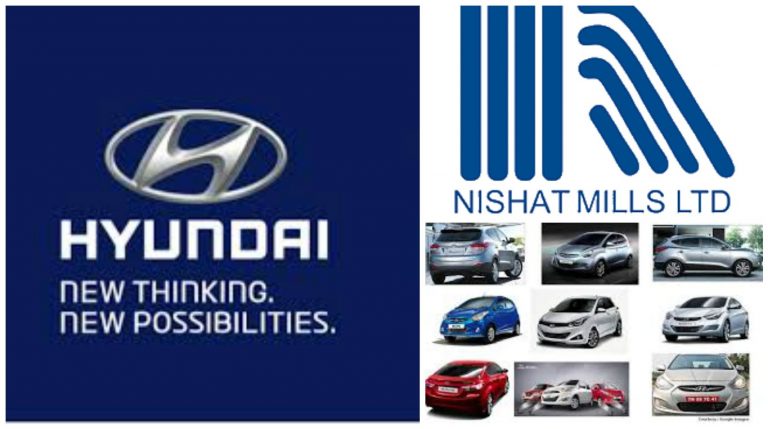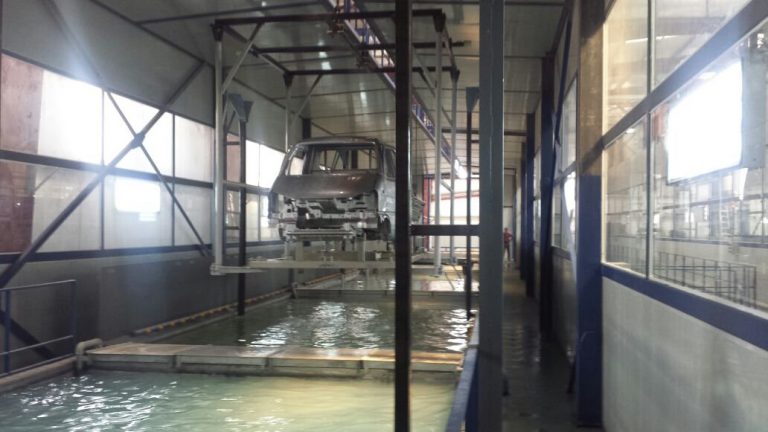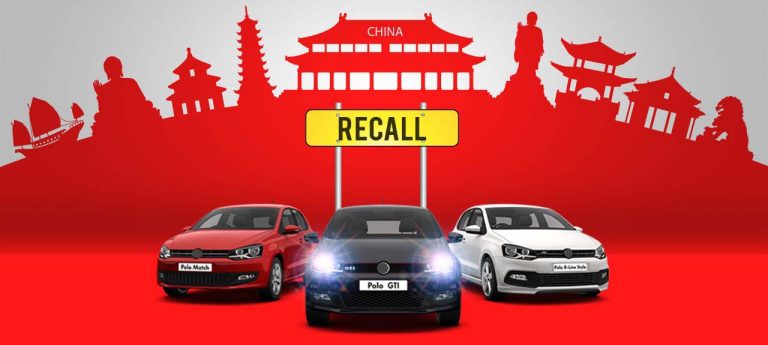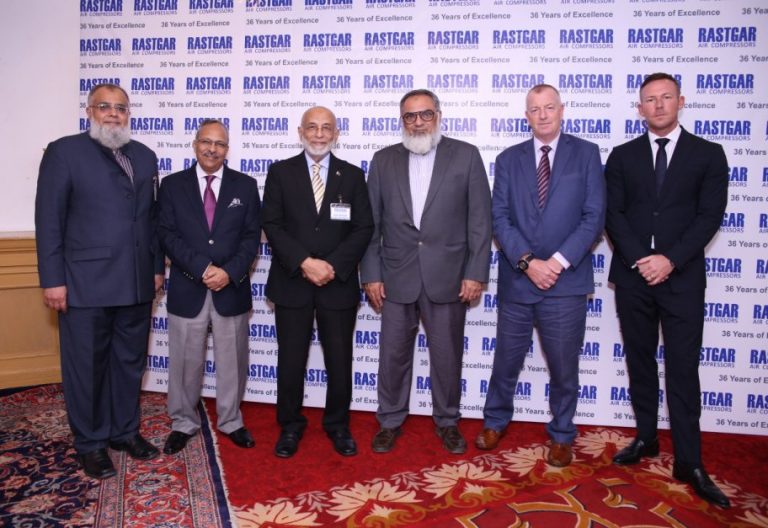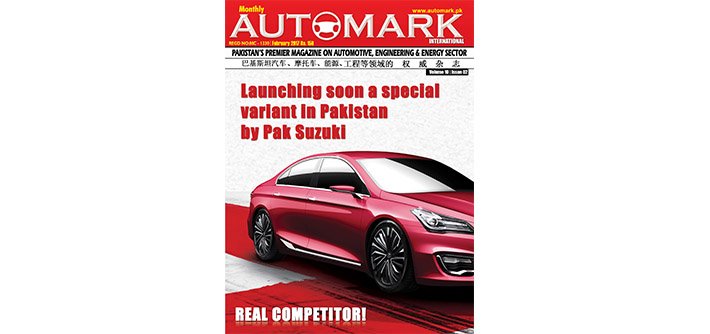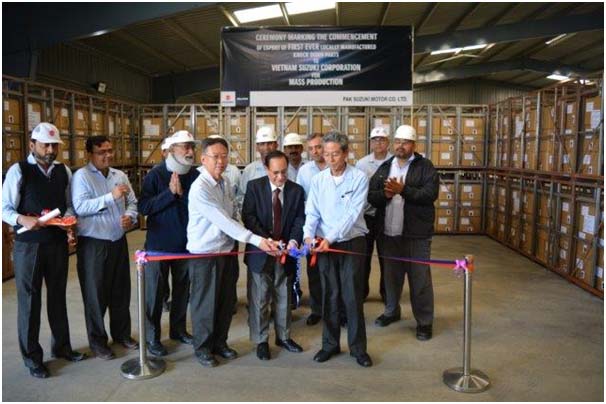Click On link to read free online copy of Automark April 2017 edition
DARSON INDUSTRIES COLLABORATE WITH BUTSCH GERMANY AT HANNOVER MESSE 2017 FOR SUPPLY OF RUBBER PARTS TO EUROPE
Darson Industries Pvt Ltd Wazirabad, manufacturer of automotive rubber hose pipes and rubber moulded parts signed a collaboration agreement with Butsch GmBH Germany for sales of automotive rubber products to vehicle manufacturing industry in Germany and other European Countries. Mr. Thomas Butsch, CEO of Butsch GmBH, a leading company in Europe which had 12 million Euro Turnover in 2015-16 and Mr. Abdul Hamid, CEO Darson Industries signed the document at Pakistan Pavilion in Hannover Messe 2017 organized by Engineering Development Board (EDB) in collaboration with commercial office, Embassy of Pakistan, Berlin.
The signing ceremony of the agreement between Darson and Butsch was presided by H.E. Jauhar Saleem, Ambassador of Pakistan in Germany. Mr. Jehangir Mushtaq Virk, Commercial Councellor Berlin and Mr. Asim Ayaz organizer of Pakistan Pavilion from EDB´s side also witnessed the ceremony as official observers. Under the agreement, Darson will be the manufacturing hub while Messrs Butsch will act as holding, distribution and customer services representative in Germany. The Darson and Butsch synergy will provide Darson with in roads to the European Auto makers. Darson and Butsch will together develop the products and place them in serial production.
It is pertinent to mention that the two companies met at Hannover Messe in 2006 and 2007 organized by the Engineering Development Board of Pakistan. The automobile industry of Pakistan has started benefits from participation in Hannover Messe 10 years ago i.e. when the two companies met for the first time.Thereafter, the two companies at several occasions reviewed the possible collaboration opportunities – it was only last year i.e. Pakistan´s participation at Hannover Messe 2017 that the efforts and thoughts of both the companies started to consolidate.
Chairman, Pakistan Association of Automotive Parts and Accessories Manufacturers (PAAPAM), Mr. Mashood Ali Khan, who is participating in Hannover Messe 2017 as an organizer of group participation from PAAPAM, highlighted that promotion of engineering sector needs efforts on long term basis. The Darson-Butsch collaboration is an example of the continued participation which will increase the confidence of German and other European Buyers on Pakistani Auto Part Manufacturers as well. Chairman PAAPAM appreciated the continuous efforts of EDB which have resulted in converting opportunities into real business.
The ambassador congratulated representatives of both, Darson and Butsch for entering into a new business relationship. He also lauded the efforts of EDB for promotion of engineering sector and emphasized that Pakistan can only enhance its exports significantly through enhancement of engineering exports. He appreciated EDB for its efforts and urged that Pakistan´s Engineering Sector should be supported on long term basis for market development initiatives such as support for participation in engineering trade fairs.
#automark #pakisan #germany #hannover
PAAPAM CHAIRMAN TO LEAD MEMBERS TO GERMAN EXPO
KARACHI: Chairman of the Pakistan Association of Auto Parts and Accessories Manufacturers, Mashood Ali Khan, will lead members of the Association at the Hannover Messe, the world’s biggest industrial fair in Hannover, Germany, scheduled to take place from April 24 to 28, 2017. The 30-member PAAPAM delegation will exhibit at the event under the umbrella of the Engineering Development Board, who have organized and spearheaded the Pakistani Entrepreneurs’ participation at the mega global event.
PAAPAM members will showcase their products at the PAAPAM Pavilion at Hannover and meet up with top 10 associations of the auto industry world. They will also organize a seminar on “Pakistan – Emerging Markets & Vast Opportunities”. The association will take this opportunity to invite other associations, entrepreneurs, and German government officials to Pakistan, to develop liaisons between Pakistani entrepreneurs and international associations to develop future prospects.
Additionally, seven Pakistani companies will be participating in the Automechanika Dubai Exhibition, from May 7 to 9, 2017. Automechanika, being a leading international trade fair for the automotive service industry, targets trade visitors from the broader Middle East countries. Last year, more than 500 visitors attended the event from Pakistan alone. The Trade Development Authority of Pakistan has organized a national pavilion for the participating companies at the Automechanika, where Pakistani exhibitors include Diamond Tyres, Pakistan Accumulators, Electropolymers, Kortech Auto Industries, Volta Dies & Molds and Rastgar Engineering
RETURN OF HYUNDAI MOTORS IN PAKISTAN
Hyundai Motor Company plans to set up a car assembly plant in Pakistan in a joint venture with local textile firm Nishat Mills and Sojitz Corporation Tokyo another local tractors assemblers, Millat Tractors shall also be minority share holder.
Hyundai used to assemble cars in Pakistan until 2004 but withdrew after their local partner Dewan Farooque Motors Limited went into financial turmoil and forced to close the operations of its automobile assembly plant.
The following announcement was made by the Nishat Group.
“The board of directors of Nishat Mills Limited has resolved to enter into a memorandum of understanding with Hyundai Motor Company (HMC), Seoul and Sojitz Corporation, Tokyo for negotiating and establishing a framework for setting up a green field project for assembly and sales of HMC passenger and one ton range commercial vehicles in Pakistan,” said a notice issued to the Pakistan Stock Exchange.
“The (South) Korean car maker wants to first start the assembly of small cars that could compete with the existing (Japanese) assemblers already operating in this market. Local; partner i.e Nishat group is trying to convince them to also bring electric and hybrid cars.
The group has already acquired the land for the plant near Faisalabad and will invest $120 million in the project. Nishat Group will have 42% stake in the new company with Millat Tractors holding 18% and Sojitz Corporation – a Japanese firm, 10%. The remaining share holding will go to country’s stock market.
Last year, the government unveiled new auto policy to attract investments into assembling and manufacturing of vehicles in the country, currently ruled by three Japanese automakers, namely Suzuki, Honda and Toyota.
Besides, there is still a huge demand of automobiles in Pakistan. “Pakistan’s car penetration of 13 vehicles per thousand persons is significantly lower than the regional average of 162”. The report said there is a strong potential for automobile growth due to higher disposable income and low interest rate environment.
Nishat Group
Nishat group of companies is a premier business house of Pakistan. The group has presence in all major sectors including Textiles, Cement, Banking, Insurance, Power Generation, Hotel Business, Agriculture, Dairy and Paper Products. Today, Nishat Group is considered to be at par with multinationals operating locally in terms of its quality products and management skills.
Nishat Mills Limited is the flagship company of Nishat Group. It was established in 1951
The Company’s production facilities comprise of spinning, weaving, processing, stitching and power generation.
Now Nishat Mills is officially moving into the automobile industry through its union with Hyundai Motors. The Nishat Group, owned by the Mansha family has its toes in banking, cement power, and many other sectors and now is broadening its horizons by entering into the auto industry.
The chairman of the group is Mian Muhammad Mansha who is a prominent Pakistani industrialist and entrepreneur with major businesses setup in Pakistan. With decades of success to his credit, he is among the highest tax paying individuals in Pakistan. He is also the Chairman of MCB bank and Adamjee Insurance Company.
Sojitz Corporation
Sojitz Corporation was formed out the union of Nichimen Corporation and Nissho Iwai Corporation, both companies that boast incredibly long histories. In April 2003, Nichimen Corporation and Nissho Iwai Corporation established a joint holding company, integrating their businesses the following year to become the Sojitz Group.
Nichimen and Nissho traced their history back to three trading company titans who played an instrumental role in the development of modern Japan. These trading companies existed, in some form, throughout the opening of Japan, the industrial revolution of the Meiji and Taisho Eras, the nation’s postwar recovery, and its rapid growth thereafter:
For more than 150 years, their business has helped support the development of countless countries and regions. Today, the Sojitz Group consists of approximately 400 subsidiaries and affiliates located in Japan and throughout the world, developing wide-ranging general trading company operations in a multitude of countries and regions.
Hyundai Motor Company
H.M.C is a South Korean multinational automotive manufacturer headquartered in Seoul, South Korea. The company was founded in 1967 and, along with its 32.8% owned subsidiary, Kia Motors, together comprise the Hyundai Motor Group, which is the world’s fifth largest automaker. However Hyundai was forwarded as small construction firm by Chung Ju-yung in 1947.
Hyundai is itself the fourth largest vehicle manufacturer in the world. Hyundai operates the world’s largest integrated automobile manufacturing facility in Ulsan, South Korea, which has an annual production capacity of 1.6 million units. The company employs about 75,000 people worldwide. Hyundai vehicles are sold in 193 countries through some 5,000 dealerships and showrooms.
The company’s first model, the Cortina, was released in cooperation with Ford Motor Company in 1968. When Hyundai wanted to develop their own car, they hired George Turnbull in February 1974, the former Managing Director of Austin Morris at British Leyland. He in turn hired five other top British car engineers. In 1975, the Pony, the first Korean car, was released, with styling by Giorgio Giugiaro of Italy, Design and power train technology provided by Japan’s Mitsubishi.
Hyundai Pony was also imported in Pakistan in limited quantity but could not be successful because of Japanese brands domination in Pakistan market.
Hyundai got first break thru into Pakistan market during Pakistan’s famous yellow cab scheme 1993. The Prime Minister Nawaz Sharif introduced ‘Yellow Cabs Scheme’ to modernize taxi service in Pakistan while giving jobless an option of self-employment.
A local importer / distributor M/s. Kandawala Motors, introduced as a cab was the Excel sedan by Hyundai Motors. The car came with a 1.3-liter petrol engine which is very economical yet powerful. Hyundai Excel had simple gear box which is better because it has five-speed manual transmission.
Hyundai had a unique thing which other cabs didn’t, this round shaped taxi sign resembling M.A Jinnah tomb in Karachi. While most of the cabs have been privatized, you can still spot handful Hyundai Excels yellow cabs in Karachi. Unfortunately the yellow cab scheme was badly failed but it becomes a fortune for Hyundai as Hyundai name as a good car, was registered / established into the Pakistani customer’s mind.
Dewan Farooque Motors Company Ltd – Former Assemblers / Licensee of Hyundai Motor Company Korea, in Pakistan
Dewan Farooque Motor Company Limited (DFML) was incorporate in December 1998. DFML made agreements with Hyundai assemble and sell their vehicles in Pakistan.
In the year 1994 DFML launch first Hyundai vehicle in Pakistan. It was a light commercial vehicle with One Ton load capacity. DFML gives it local name “Shehzore”, It is called “Porter” in Korea. The launching of this vehicle becomes a success symbol for DFML. Shehzore became market leader in its segment and defeated Toyota Hiace which was market leader at that time.
Subsequently Hyundai Santro hatchback four doors car having 1000 CC engine was launched in Pakistan by DFML in the year 2000. This was first generation Santro. This model was totally failed in Pakistan. However in the year 2003, DFML launched second generation Santro. This model was accepted by the customers and was successful in Pakistan market.
DFML was the part of Dewan Group, Dewan acquired Pakland Cement in 2004 for Rs. 1.1 billion in cash soon after which Dewan group started to post losses cascading into problems for the entire group in just 24 months. Things kept turning from bad to worst and by 2008 were vanished from mainstream news. Dewans were eventually declared the defaulters of over Rs. 45 billion. Resultantly assembly and marketing of Hyundai vehicle in Pakistan was also stopped.
What would be the future of DFML . . .
The following was officially announced by DFML in September – 2016.
“Dewan Farooque Motors is restarting its production by end of October 2016, according to an official announcement made to shareholders on Monday. Dewan Farooque Motors will be manufacturing vehicles of different segments under toll manufacturing arrangement for which the installations of jigs and fixture are in the process for assembly plants. The company also has entered into a toll manufacturing agreement with Daehan—Dewan Motor Company, which is a joint-venture between Yousaf Dewan Companies and KOLAO Group based in Lao PDR and South Korea. The revival would likely to see the re-launch of Shehzore 1-Ton single rear wheel truck and Shehzore 1-Ton truck. The company planned to launch passenger cars, light commercial vehicles and SUVs in collaboration with KIA Motors Korea in years to come”.
In current scenario both Korean automobile giants i.e Hyundai and KIA officially tied up with Nishat Group and Y.B Group. Now the question is how can DFML will be able to re-launch “Shehzore” which is basically a Hyundai product.
New entrants aim to take the auto market by storm
Amid inconsistency in the policy as always blamed by the existing auto assemblers – the new foreign auto makers are highly optimistic for a promising future of Pakistan’s car and heavy vehicle sectors especially.
They see a robust demand of cars in view of low interest rates and rising standard of living of middle class. For heavy vehicle sector they pin hopes on additional demand of heavy vehicles depending on the success of China Pakistan Economic Corridor (CPEC).
Pakistani print media in the last six to eight months have run a series of lead stories relating to the intention of European and Korean car makers dying to take a plunge in the market dominated by Japanese car makers like Toyota, Honda and Suzuki.
In heavy vehicle segment Hinopak Motors hold big a market share in trucks and buses followed by Isuzu and Nissan.
Some Chinese brands are looking forward to make a deeper inroad in view of CPEC related demand but Japanese brands are far superior in technology and quality than Chinese brands.
Arrival of new comers is certainly big news for the car buyers who are not satisfied with the products being rolled out by the Pak Suzuki especially. Vending industry must be excited for getting additional orders for part making in case more local assembly plants are set up. Besides, the new entrant arrival would also open new job avenues especially in the vending industry.
PML-N government deserves the credit of making friendly new entrant auto policy on which foreign players’ are ready to cash their luck in Pakistan’s volatile economic and political situations.
PML-N appears highly satisfied to win the election 2018 despite its unfulfilled promises on new power generation plans and insecurity situation. In case the ruling party again comes into power then it will really further prove helpful for the world car giants who have already shown their interest and some of them have inked MoU with local partners besides purchasing land for the new plants.
However, in case the Pakistan Peoples Party takes control of the country in 2018 polls then it is hard to say whether the new government will maintain the policy of PML-N government of encouraging foreign investment in auto sector or it will change or amend the policy.
Certainly the result of 2018 elections must be in mind of the foreign car and heavy vehicle assemblers who will also decide whether they would honor their past commitment and confidence which they have shown now to the PML N government or will roll back out in case other than PML N government comes in power and introduce changes in the policy.
Sources said that new entrants are slowly and cautiously moving towards their future plans in view of 2018 elections and its results. However, purchasing land by car giants is not a heavy burden on them as land prices have always paid very high in Pakistan especially in PML-N government rule since May 2013.
However, the existing car assemblers have always blamed inconsistency in the policy of various governments due to which they (especially Pak Suzuki and Indus Motors) could not introduce new models.
The governments have also encouraged used car imports which definitely eroded the market share of existing assemblers. Despite this huge interest of European and Korean players to set up assembly plant is surprising as they are relying on incentives which the new auto policy 2016-2021 has promised.
Perhaps the buyers’ rising tilt towards used cars and their thriving imports have lured foreign players to tap the potential.
Contrary to the reality that bulk of imports comprise of used 660-1,000cc vehicles the European and Korean car assemblers intend to introduce their low engine power vehicles which will compete with used cars as well as local made Japanese cars.
One of the things to lure foreign car makers is absence of any strict action by the previous and current governments on increasing car prices by the assemblers. The governments had never taken to the task the assemblers for pushing up prices three to four times a year on currency parity and other excuses. Even the on money menace still exists due to delivery of vehicles in three to six months.
It seems that these players are not interested in taking a big slice or give a tough time to the existing players. They will initially focus on the volume of 40,000-50,000 units which the used car importers have captured by bringing in three years old vehicles under various schemes introduced by the government.
As the Budget 2017-2018 is round the corner, used car importers have started building up pressure on the government for more concessions so that consumers can get easy access to the high quality used cars. On the other hand, local car assemblers will do their best to avert the pressure of used car lobby urging the government to further tighten used car imports so that their market share could improve.
Chairman All Pakistan Motor Dealers Association (APMDA), H.M. Shahzad urged Finance Minister Ishaq Dar that the car assemblers continue fleecing the people in the shape of advance payment at the time of booking of a car and delivering the vehicle in three to six months. As a result of delays in car delivery, the black marketer charges a hefty premium “on money” from the people.
He said assemblers arbitrarily increase the price of their cars as and when they desire. After allowing Import of three years old car model – the local assemblers are enjoying monopoly on prices besides providing limited choices for the buyers.
Shahzad urged the government to allow commercial imports of used vehicles of up to five years of age limit in addition to existing import of vehicles under various schemes. It would also bring the import of used vehicles business into the tax net and help the Government expand its tax base.
He said the local industry had never passed on the impact of depreciating Yen to the consumers in shape of price cut in cars.
He suggested the government to impose a fixed rate of duty on the import of used vehicles of engine capacity of above 1,800cc.
The government, sources said, is unlikely to accept demands of the used car importers in new budget as it could not afford to ruin its plan of encouraging investment from European, Korean and Chinese assemblers.
However, the incentives for new entrants appear highly attractive for which the existing assemblers like Pak Suzuki, Al Haj Faw Motors and Dewan Farooqui Motors are struggling to get same on which the government has so far not given any green signal.
Pak Suzuki with an investment plan of $660 million has sought same benefits/incentives for two years from the start of mass production of new models instead of five years granted to new entrants in the Auto Policy 2016-21.
Al-Haj Faw had requested for new entrant status under the new ADP 2016-2021 as Greenfield. The company opined that the new policy deprives companies of any benefits and as such it would not be able to compete with new entrants.
Daehan Dewan had requested the government for granting Brownfield status to their unit under new ADP 2016-2021 for production of Daehan, Ssangyong and KIA range vehicles.
The cases of Al-Haj and Daehan Dewan were referred to Ministry of Industries highlighting the facts that though these are not exactly within the strict parameters of ADP 2016-21, both matters present opportunities for investment, competition in the market and thus might justify special treatment.
However, the ministry felt the treatment can trigger similar requests from others and company specific modifications in the ADP 2016-21 at this stage as it would counterproductive.
Perturbed over lukewarm response to earlier requests, Pak Suzuki said it would review its decision to invest $460 million if the government fails to respond to its request for incentives until April.
Pak Suzuki, which has purchased the land, said total promised investment is around $660m in which foreign direct investment from Japan is $250m. PSMCL is going to arrange $210m through its own funds and bank borrowings while vendors will invest $200m. This is a one-time investment. The plant’s completion will be in 18-24 months.
Coming to new entrants, leading business groups, who had made huge profits in their decades old business, are now ready to take the auto market by storm.
Nishat Group, which has recently entered into an agreement with Hyundai Motor Company to set up a car assembly plant in Pakistan, is planning to introduce electric and hybrid passenger cars. It wants to first start the assembly of small cars to compete with the existing Japanese assemblers.
The company would import these cars in the beginning and later also start assembling them locally. Nishat Group would invest $120m in the project that will be set up in an industrial zone near Faisalabad. The company has acquired land for the plant.
Nishat Group will have 42 per cent stake in the new company with Millat Tractors holding 18pc and a Japanese firm 10pc. The remaining shareholding will be offloaded on the country’s stock market.
Lucky Cement, a company owned by one of Pakistan’s largest business conglomerates Younus Group, has partnered with Kia, yet another Korean car brand, to assemble cars as well as commercial vehicles in Karachi.
French car maker Renault plans to invest $100m in the Ghandhara Nissan plant to bring its brand into Pakistan.
It is not clear how Hyundai and Kia would create new interest among the customers who had already experienced these vehicles introduced by Dewan Motors which later wrapped up these projects in late 2000s due to financial problems. Hyundai and Kia had low resale value at that time.
German car maker Audi AG expresses intent to assemble vehicles in Pakistan by setting up a plant. Through its authorized importer in the country, it has submitted a letter of intent to the Board of Investment (BoI) for consideration.
The land for the plant has been purchased in Korangi, near one of Pakistan’s biggest industrial estates, and would mean a fresh investment of over $30 million which looks meager as compared to investment by Korean counterparts.
Audi representative in Pakistan foresees the prices of lower-engine models to decrease in the range of 5-10 per cent if assembled in Pakistan. With regards to the heavier engine models – over the 1.8L categories – he sees a much bigger decrease of around 20pc.
He means the A3 model, currently priced at Rs4 million, could come down to between Rs3.6 million and Rs3.8 million.
It is not clear how Audi would survive on very low volume of sales per year for which it needs special incentive from the government. Due to lack of volumes – some assemblers had already packed up their business in Pakistan while existing assemblers say that they could not invest in new models due to thin growth in volumes and inconsistency in government policies.
Even low volume would also not attract any local vendors. The German car maker would require at least 15-20 years to procure local components from the vendors depending on attractive sale volume.
BMW is planning to launch lower end and mid range models in Pakistan, which is surprising that how a luxurious models can be cheaper.
As per media reports – BMW hasn’t decided to set up a local car assembly plant though.
The major attraction for foreign companies is the new policy which allows these investors to import tax free manufacturing plant equipment and pay less taxes on import of parts when assembly starts plus various other incentives that can help new entrants in the automotive industry to set up their operations in Pakistan.
National Logistic Cell will invest in auto sector with German collaboration in order to cater the rising demand of heavy commercial vehicles following the commencement of China-Pakistan Economic Corridor (CPEC).
NLC has planned to install production plants [in Pakistan] with German Company to produce prime movers.
The NLC will initially be investing Rs500-700 million to install a production plant in Pakistan in a bid to manufacture heavy commercial vehicles in collaboration with German MAN Truck and Bus Company.
In the first phase, trucks will be produced to meet the requirements of Pakistan Army while in the second phase — keeping in view the rising demand under CEPC — heavy commercial vehicles will be produced as well.
Around 700-1,000 heavy vehicles will be produced annually and later on the production capacity will be enhanced accordingly.
Volkswagen Commercial Vehicles is in final talks with Premier Systems Private Limited – the authorised importer of Audi vehicles in the country – to set up a manufacturing/assembly plant for its Amarok and T6 (transporter range) models.
On one hand the government is attracting foreign car players with its new auto policy and on the other hand the Government has made a change / amendment in new auto policy through SRO 483 dated 29th June, 2016 which states that it is compulsory every light commercial vehicle assembler has to establish ED Coat Painting system in his auto assembly plant.
Al Haj FAW has invested around Rs 400-500 million for the establishment of ED painting system including the cost of land and material. This ED painting system consists of eleven tanks and backing system can bake more than one vehicle at a time. The dipping tanks and baking ovens size is too huge that can even paint and bake Prime Movers cabin.
One thing is now sure that every new entrant would need to invest Rs400-500 million at least for ED painting facilities as per government’s directives. In case the new entrants fail to achieve desired sales volume — the plant and machinery investment coupled with ED paint facility would go in waste.This is certainly a risk on which the new entrants need to ponder.
By team Automark, Exclusive article published in Monthly Automark Magazine’s April-2017 printed edition
ALHAJ FAW ALL GEARED UP TO MEET INCREASING DEMAND OF FAW PRODUCTS IN PAKISTAN
Apparently it seems that new auto policy 2016-21 is has made a positive impact on the automobile industry of Pakistan. Some big international players already announced their intentions to enter into Pakistan automobile industry like Audi, Volkswagen and Peugeot. On the other hand some Korean and European Car makers already joined hands with Pakistani partners.
Younus Brothers Group (Lucky Cement) has tied up with KIA Korea. Nishat Mills (Mansha Group) has announced that they have signed an MOU with Hyundai Korea. Renault France technical team has started working on the plant with Bibojee Group (Ghandhara Nissan). A part from this some Chinese automobile giants are also very active to enter in Pakistan market or enhancing their existing plant capacities.
AlHaj FAW Motors was incorporated in July 2006 and launched first product in October 2006, Started with two variants of heavy duty trucks. They had signed a distribution license agreement with FAW in July 2006, which allowed them to import, distribute and sell FAW products in Pakistan.
Initially they were importing Prime Mover in CBU condition from China. As far as marketing and sales was concern they had an edge over existing players that they have the capability to offer lease rental facility to the end customer with their own resource. This marketing tool gave their sales an immediate boost. On the other hand over all quality of FAW Trucks is also at par with their Japanese rivals. In November 2012 they established an assembly plant in Karachi and started assembly of these prime movers locally. In the year 2013 they started the assembly of 1000cc pickup and cargo vans in the same plant. Now they are going to start the assembly of SUV and Passenger Cars in this plant.
In the mean while the Government has made a change / amendment in new auto policy through SRO 483 dated 29th June, 2016 that it is compulsory every light commercial vehicle assembler has to establish ED Coat Painting system in his auto assembly plant. Now fortunately AlHaj FAW has attained that sales volume which can justify the investment cost of ED Painting System. AlHaj FAW is investing around Rupees 40/50 Crores for the establishment of ED painting system including the cost of land and material. This ED painting system shall be consists of eleven tanks and backing system can bake more than one vehicle at a time. The dipping tanks and baking ovens size is too huge that can even paint and bake Prime Movers cabin. This would be of the latest ED painting facilities in the country. Design and technology is from Korea and China. The installation and test time of this facility is around six months.
AlHaj FAW is fortunate enough that they have the back up of one of the largest automobile group of China. They are able to introduce any type of “Product Mix”. It means, light commercial vehicles, passenger cars, medium duty trucks, electric cars, hybrid cars in one time. This “product mix” give them the advantage of attaining the target of high sales volume in a short time which can easily justify the investment of Forty Crore Rupees in ED Paint Shop establishment.
The joint venture between FAW group, China and AlHaj group Pakistan, the automaker was able to launch their successful 1.3 L hatchback. FAW V2 is a good car with all the basic and some additional features which surely are lacking in our local cars.
The automaker has many different offerings in the heavy duty vehicles which include J5M 220 HP 4×2, J5M 280 HP 6×4, J5P 330HP 6×4, J5P 420HP 6×4 and FAW Tiger V. FAW Tiger V was recently launched in Pakistan and success is on its way.
In the past, when Chinese automakers came to Pakistan, they unfortunately partnered with weak groups or those who did not have a long term plan. This is what left a bad image on Chinese vehicles. It is not necessarily about the product being inferior in quality; it is just the image that created problems. But after bad experiences, Chinese companies are now smarter in picking partners.
There are many other companies who are planning to enter into Pakistan automobile market in cooperation with Chinese OEM but relatively on a smaller scale. These companies are mainly focus on light commercial vehicle segment. It may be noted that the investment cost of normal / conventional painting system is around two crore rupees. If we analyze the economic viability of these upcoming project in reference to sales / production volume and payback period of investment, one can easily understand the difference of 40 crore and 2 crore rupees. So if a new comer / investor install ED coating painting system the project will become totally unviable. In our opinion for a healthy competition “level playing field for all,” formula should be adopted. Existence of relative small companies should also be guaranteed, otherwise only big giants of the international stature will be benefitted with the new auto policy and government hopes and objectives shall not be materialized. As a result situation of unemployment will not improve. The old players of automobile industries shall maintain their monopolized stature and new big international automobile industry giants will join their “monopoly club”. Customers will suffer immensely and forced to pay huge premium money as usual.
Specially light commercial vehicles plays a pivotal role in progress of economy. They are suitable for inter city transport of goods. They are the main tool to transport agriculture goods from farms to main roads. They also use for the transportation of passenger in country side and in small towns. These are utility vehicles, do not need extraordinary cosmetics. Their main function is loading of goods, so customer wants
powerful engine and sturdy chassis.
ED (Electro deposition) Coating process actually increases the body life of the vehicle as it provides.
– Excellent resistance to corrosion.
– Realization of uniform High quality Paint coating free from Rag, Pinholes and Body rashes.
– Friendly to environment with reduced coating loss and solvent discharge.
First Automobile Works is a global contributor in the automotive industry with a 50 year history of innovation. The company FAW was established in 1953 and the name was changed to China FAW Group Corporation in 1992.
Car Defects and Recalls
RECTIFIED POTENTIAL VEHICLE RECALLS CAN BE SAFE FOR MOTORISTS
Today, cars are being manufactured with the latest innovated automotive technology and most advanced features. In facts, 75% are made by robots and 85% car operations are controlled by computers, and when mass production cars turns into millions, there could be possibility of minor defects left in the vehicles. It all depends on where (Plant location) and when(production date) that particular car was made, based on the 17-digit VIN (Vehicle Identification Number) found mostly on the driver door pillar or front dash which can be viewed from front windshield.
It goes without saying that vehicle recalls, once identified by car manufacturers and Ministry of Transport of local government, must be notified to both dealers and their customers.
Today, raised awareness of liability claims resulting from potential safety issues has led auto manufacturers to consider recalling their vehicles even when there is only a very slight risk stemming from safety, liability and quality concerns.
When such recall news is released through the media, it can often cause customers to panic, which can result in a difficult situation for the dealers.
However, like many other aspects, it is often how the dealer handles customer concerns that will have a bearing on the future in terms of relationships and business.
MOST COMMON QUESTIONS ASKED BY CUSTOMERS
What is car recall?
An auto recall occurs when a manufacturer determines that a car model (or several models) has a safety-related defect or does not comply with a safety standard. When this happens, the automaker will alert owners to the problem and usually offer a free repair. Keep in mind that a recall doesn’t mean that the entire vehicle will be replaced.
What does a recall letter/notice include?
A recall letter should contain the following information:
• A description of the defect based on model and production period.
• The risk or hazard posed by the problem (including the kinds of injuries it can cause)
• Potential warning signs
• How the manufacturer plans to fix the problem (including when the repair will be available and how long it’ll take)
• Instructions regarding what you should do next
What should I do if I receive a recall letter/notice?
The recall letter should have instructions as to your next steps. Generally, you’ll be instructed to call your local dealer to set up a repair appointment.
What if don’t receive a recall letter?
When a recall is issued, manufacturers will do their best to contact all affected owners. If you don’t receive a car recall notice, however, you can contact your dealer. Whether you have received a letter or not, the manufacturer is still obligated to repair the defect (for free).
Does a safety recall mean I ‘m in immediate danger?
No, unless it is related with safety of your car such as brakes. If your car is on a recall list, it doesn’t automatically mean you’re in danger. However, if you learn that your car has been recalled, its best not to take the risk especially with recalls related the brake system. Have your car repaired as soon as possible, especially if the defect could pose a major hazard.
Do I have to pay to have my car fixed?
No! If your car is on recall list, all recall-related fixes should be done free of charge. You’ll need to take your car to an authorized dealer since they contract directly with the manufacturer. And to avoid complications, it’s best to bring your recall letter with you (if you have one).
If your dealer tries to charge you for the recall fixes, ask to speak to a manager and explain the situation. If you still run into issues, your next step is to contact the manufacturer directly (their number should be provided in the recall letter).
Will the problem be fixed?
Good question. The local government’s transport ministry monitors each safety recall to ensure the manufacturers provide owners with safe, free, and effective remedies. If you’re concerned that the error wasn’t resolved or believe a further problem exists, contact head office of your local car manufacture or Ministry of Transport.
Do I have to pay for extra?
You don’t have to pay for repairs to parts that have been recalled, but some drivers could still end up with a bill. Any extra work that the dealer may recommend is not mandatory and not covered. Some dealers feel that the recall issue of a car is an opportunity to build a business relationship with the customer.
Will I be facing delay?
Many car owners may face long delays before getting a car fixed. There can be a delay if parts aren’t ready, but this can be a huge disadvantage to owners/drivers, some of whom might feel pressured to keep driving a car that they need but don’t feel is safe.
However, car manufacturers do need to fix the car, but there is no requirement that they fix it right away, unless it is unsafe to drive. Some dealer may provide rental or loaner car while your car is in the shop for fixing recall issues.
As authorised dealers, do not hide recalls to make money later. In fact, follow up and encourage your customers to bring their car in to fix genuine recall concerns and issue alternate transport if required. At the end of the day, customers can save substantially on unexpected repairs resulting from recall campaigns.
For dealers, the key question is not whether your dealership will face a recall, the question is when. Is your dealership staff is fully trained and ready to respond to and stay in control during these events? There is only one way to minimize risk during this situation – be fully prepared to face a recalls.
Consider recalls as an opportunity to invite new and welcome back lost customers to explore and expand service business, and in many cases dealers can improve customer retention and loyalty by fixing free recalls issues that could translate into prospective business.
Written by: Muhammad Shahzad exclusive for Monthly AutoMark Magazine’s March-2017 printed edition
Improving Quality of Air for Industry and Caring for the Environment
Rastgar Air Compressors Hosted a Dinner for Honoring Pakistan’s Industry
9th March, 2017 Karachi:The need for high quality air for meeting the needs of Food, Pharma, textile and other industries was stressed by Chairman, Imtiaz Rastgar while addressing guests at a dinner in honour of dignitaries from manufacturing industries and the visiting team from Gardner Denver FZE, UAE.
“It is part of our corporate social responsibility to attend to the Compressed Air utility in industry so as to supply the appropriate quality of air to each process at the lowest possible energy cost”, said Imtiaz Rastgar.
Rastgar & Co, Authorized distributor of CompAir Air Compressors in Pakistan, hosted a dinner on 8th March, 2017 at Marriott Hotel, Karachi, Pakistan to honor industries of Pakistan for their business to Gardner Denver FZE and Rastgar.
Mr. David Fenwick, Director Sales Gardner Denver FZE, specially thanked industrialist for showing confidence on CompAir Air Compressors and Rastgar services.He met individually to all guests and spoke about latest innovation in compressed air technologies to make their businesses more profitable, with more energy efficient and productive machines.
Managing Directors, CEOs and Directors from major industrials groups and Associations of Pakistan attended the dinner and appreciated the efforts put in by Rastgar Air Compressors for offering reliable products and aftermarket services. Some of the guests were Mashood Ali Khan, Chairman PAAPAM, Haseeb Ahmed, Director Sitara Chemical Industries, Tariq Haroon Dada, EVP TATA Textiles, Qamar ud Din Khan, CEO Mehran Commercial Enterprises, Adnan Yousaf, MD Transpak Ltd, Dr. Rajpoot, Technical Director Nabi Qasim Industries, Asif N. Ansari, GM Hilton Pharma, Menin, CEO Shamrock and many more.
Gardner Denver is a leading global provider of flow control technology, application expertise and support services to a diverse customer base through a family of trusted brands.CompAir, A brand of Gardner Denver, focuses on developing engineered solutions for its customers’ biggest operational challenges, with an emphasis on providing absolute reliability, increased efficiency and lower energy expenditures wherever possible.Ground breaking compressed air technologies, such as Quantima, deliver superb efficiency and performance. Plus with the dedicated in-house AirEnd manufacturing CompAir is able to specifically influence the performance of the compressor to achieve the highest levels of reliability and efficiency
Rastgar Air Compressors is authorized distributor of CompAir Air Compressors in Pakistan. For more information visit www.rastgar-co.com
Pak Suzuki exports 1st Ever Knock Down (KD) parts to Vietnam Suzuki Corporation
Pak Suzuki Motor Company Limited achieved yet another milestone for being first in the history of automobile industry of Pakistan to commence locally manufactured Knock Down (KD) parts’ export operations to Vietnam Suzuki Corporation for mass production of Suzuki mini-truck model.
In this regard, a ribbon cutting ceremony was held at Pak Suzuki Motor Co. Ltd., Bin Qasim Plant, Karachi on 09th January, 2017. Mr. Hirofumi Nagao, Managing Director and CEO of Pak Suzuki and Mr. Abdul Razzaque, CEO of M/s. Metalline Industries were chief guests on that occasion.
The 1st ever locally manufactured knock down (KD) parts’ exports consignment was shippedby sea from Karachi International Container Terminal (KICT) on 20-Jan-2017.
This step by Pak Suzuki will further contribute towards the national economy in the form of foreign exchange revenue. Pak Suzuki is already among the top list of OEMs contributing a substantial amount in terms of duties and taxes towards the national ex-chequer.
Pak Suzuki has plans to further enhance the export market operations for locally manufactured knock down parts.
